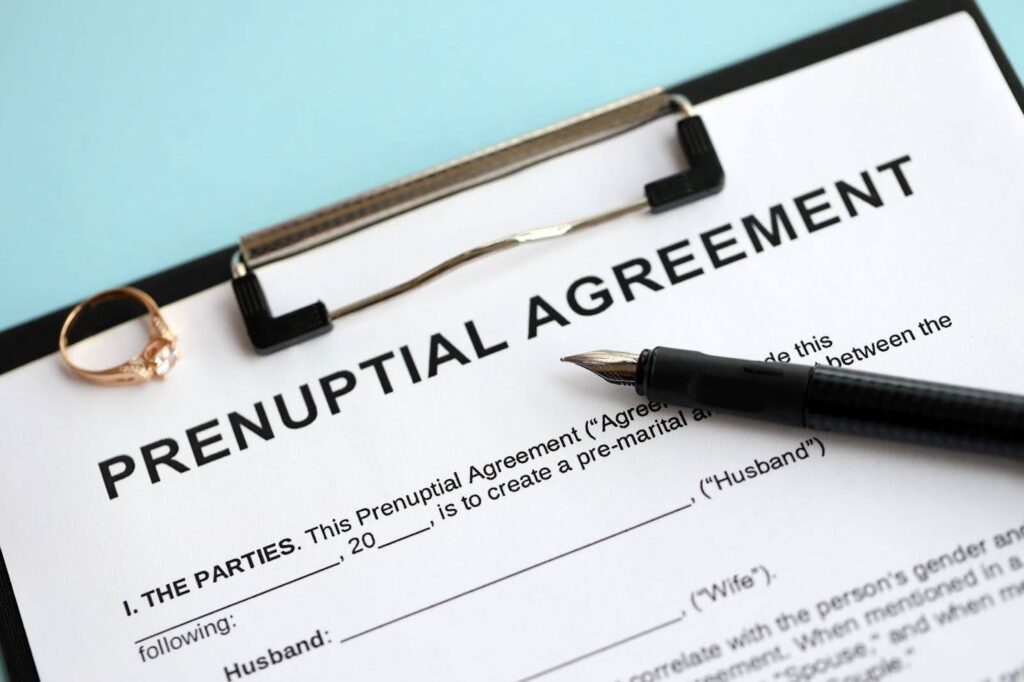A prenup in California is a premarital agreement that will help protect you in the unfortunate case of a future divorce. This is important because while no one marries with the intent to divorce, the future is unpredictable, and it is best to protect your financial future and limit conflict. Knowing what to include in your California prenuptial agreement checklist is wise.
If you want to learn more about the requirements and marital laws regarding prenups, keep reading.

California Prenuptial Agreement Checklist
While there once was a negative outlook on prenuptial agreements, today, in California, the number of couples seeking a prenup has surged. Couples use prenup checklists to do the following:
- Protect individual assets
- Set expectations
- Avoid future disputes
Prenuptial agreements in California are especially useful in marriages with significant financial disparity between marital partners. Often, one spouse enters a marriage with significantly more wealth or debt than the other.
In such cases, a prenup outlines how finances will be handled in the case of a divorce. The best way to ensure your prenup agreement is valid and enforceable is with the help of a California marital lawyer.
Understand California Prenup Requirements and Laws
To ensure your prenup is valid, you and your future spouse must understand California’s prenup requirements and laws. If you do not set up the prenup as per the state’s laws or if you have a prenup that was made in another state, it may prove invalid in the State of California.
First, when setting up your premarital agreement, remember California’s laws, more specifically, the community property laws and the UPAA (Uniform Premarital Agreement Act).
Community Property Law
California is a community property state, which means that during divorce, there is a 50/50 division of assets acquired during marriage. Community property in California is considered:
- Anything either spouse earned during the marriage
- Anything either one bought with money earned while married
- All the debts the couple accrued while married
Uniform Premarital Agreement Act (UPAA)
California follows the UPAA for prenups, regulating how they must be created and enforced. California adopted the UPAA in 1986, which applies to all prenuptial agreements made since then.
The UPAA is outlined in California’s Family Code sections 1600 to 1617.
- Section 1600: Defines a “premarital agreement” as an agreement between future spouses, which is to be effective upon marriage.
- Section 1611: A prenup must be in writing and signed by both spouses. The agreement is enforceable without consideration.
- Section 1612: Allows the spouses to address a wide range of topics, including property rights, property disposition, creating wills and trusts, and spousal support. This section also outlines that the prenup may not negatively impact the right of a child to support.
- Section 1613: The premarital agreement is effective upon marriage.
- Section 1614: If a couple wants to amend or revoke a prenuptial agreement after marriage, it may do so only with a written agreement signed by both parties. The amended or revoked agreement is enforceable without consideration.
- Section 1615: This section outlines situations where a premarital agreement is not executed voluntarily or is unconscionable.
- Section 1616: Addresses the enforcement of a prenuptial agreement if a marriage is void.
- Section 1617: Covers the statute of limitations during marriage and the equitable defenses that limit time.
Prenuptial Agreement Requirements
If you want to ensure your prenup will be considered legally binding in California, it should meet the following requirements:
- Both parties must have enough time to study and understand the agreement before signing it. In California, it is required for prenups to include a seven-day wait period for both to seek legal counsel and fully understand what they are signing.
- To be legally binding, both partners must sign the prenup with full awareness of its contents and under no improper influence.
- The prenuptial agreement is in written form and signed by both parties.
- All of the terms of the premarital agreement are lawful.
Discuss Financial Expectations Early
If you and your partner are thinking of getting married, it is wise to set your financial expectations from the beginning. It is important to ensure you both have enough time for honest conversations about your finances and goals.
Open communication about finances early on will help you both enter the marriage with clear expectations regarding each person’s financial assets, debts, and expectations before marriage.
A prenup lets you both list assets you want to protect in the unfortunate case of a divorce. Personal assets that you may list in your prenup include:
- Personal property
- Real estate
- Business interests
- Retirement accounts
Disclose All Assets and Debts
For a valid and legally binding premarital agreement, it is a legal requirement that both you and your partner provide full and fair disclosure of both of your financial situations.
You should create a detailed list of all assets and debts, including bank accounts, properties, and liabilities. All of these and fall into the separate category assets that you bring into the marriage are referred to as “premarital”, and fall into the category of separate.
According to California’s marital laws, separate property belongs to the person who earned them. Besides assets acquired prior to marriage, the separate property also includes gifts or inheritance that either spouse earns during the marriage.
The lists of assets and debts made by both parties should be exhaustive. The list of premarital assets can include anything earned up to the date of the marriage, including:
- Real estate property
- Savings and brokerage accounts
- Retirement funds
- Vehicles
- Jewelry
- Home
- Employee stock options
- Debts and liabilities

Determine How Assets and Debts Will Be Handled During Marriage
Your prenuptial agreement should clearly define what constitutes marital and separate property. Some couples may choose to fully waive community property so they do not automatically acquire joint assets during the marriage.
In such cases, if the couple wants to acquire a joint asset at a later time during their marriage, they will need to have a discussion and jointly title them to make them community property.
Generally, it would help if you discussed how you would handle the following during your marriage:
- Determine how your premarital assets will be handled during and in the event of a divorce.
- Decide whether your separate property will remain such or will become intermingled with your marital property.
- Discuss debt management. For instance, if you choose to separate them in the event of a divorce, the debts will go back to the person who acquired them.
- How will you handle it if one spouse’s premarital asset is used to pay off the other’s premarital debt? Discuss if the paying party will be reimbursed or if the paying off will be considered a gift.
- Discuss how you will make financial decisions and if you and your spouse will have joint or separate bank accounts during your marriage.
Address Spousal Support (Alimony)
As we mentioned, in accordance with section 1612 (c) of California’s Family Code, a couple may put in their prenup that they will limit or give up rights to alimony if they ever divorce.
The limit or waiving of spousal support in the event of a divorce is generally enforceable as long as it’s not unconscionable. In other words, if it is not extremely unfair to the spouse who is waiving the support.
For instance, if the other spouse may be forced into welfare after a divorce while the other has the means to provide support, the court is unlikely to enforce a waiver of alimony.
Waiver of spousal support will also not be enforceable if independent legal counsel did not represent the other party at the time the prenup was signed.
According to California courts, waivers of alimony are mainly upheld between spouses who were self-sufficient in earning ability and assets at the time of signing the prenup.
Plan for Division of Property in Case of Divorce
While separation may be the last thought in mind when preparing for marriage, it is important to include plans in your prenuptial agreement if a divorce occurs.
Your premarital agreement should include plans regarding asset division upon divorce and how you will handle businesses and inheritance. If you want separate property to remain separate, include that. The same goes in the other situation if you want to turn it into community property after marriage.
In terms of inheritance, prenups can include waiving the right to inheritance for spouses. This is common with spouses with children from previous relationships, who want to ensure the assets are passed to the children.

Conclusion
Prenuptial agreements are incredibly beneficial for partners who are considering marriage. They help protect your assets in the event of a divorce and help you and your partner set clear expectations for your marriage.
If you still have questions about your California prenuptial agreement checklist, contact us and one of our marital lawyers will guide you through the process.





